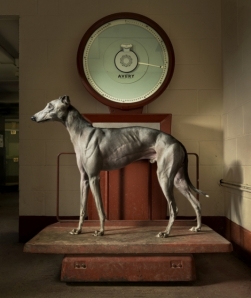Boulevard du Temple was taken in Paris in 1838/1839 by Louis Daguerre, inventor of the daguerrotype process – the first commercially successful photographic process. The picture’s of a street scene, but the 10+ mins exposure time captured the man getting his boots polished in the bottom left of the shot – the only thing (other than the building) who kept still enough to be captured.
Posted in photography | Tagged Boulevard du Temple, daguerrotype, early photography, first photo of a human, Louis Daguerre | Leave a Comment »
When Francis Masson brought this giant cycad from South Africa to Kew Gardens in 1775, it didn’t get to shrivel up in a small pot on the windowsill next to the sink. On the contrary, when the world-famous gardens opened its Palm House in 1848, it was one of the first plants to be moved into it. The plant, which produced its first (and final) cone in 1819 is still alive today – it was repotted in 2009 to celebrate the gardens’ 250th anniversary. Because Encephalartos altenseinii weighs more than a tonne, a gantry was needed to lift the massive trunk and root ball out of its old container (in which it had lived since 1984).
Posted in Nature/gardens | Tagged Encephalartos altenseinii, Francis Masson, giant cycad, Kew Gardens, world's oldest pot plant | Leave a Comment »
 The first recorded case of dognapping in the UK involved the taking of Hi Joe, an uber-fast racing greyhound who went missing from his kennel in Essex on a frosty night in January 1965, sparking a nationwide search and capturing the attention of the international press.
The first recorded case of dognapping in the UK involved the taking of Hi Joe, an uber-fast racing greyhound who went missing from his kennel in Essex on a frosty night in January 1965, sparking a nationwide search and capturing the attention of the international press.
The favourite for the Derby, Hi Joe was owned by prominent bookie Victor Chandler. At just two years old, he had won 10 out of 14 races, including all of his last six and had romped around the famous White City 525-yard track in a record 28.72 seconds, a feat he went on to repeat two weeks later. The Puppy of the Year for 1964 looked to be on course to challenge the legend of all-time champion dog Mick the Miller. Until his trainer arrived home from a night at the races to find him gone…
Posted in Dogs, Uncategorized | Tagged first recorded dognapping, greyhound, greyhound racing, Hi Joe, Mick the Miller, White City | Leave a Comment »
It’s amazing to think that one of the most expensive photographs ever sold should be of the inside of an ultra-cheapo 99c store, but life’s funny like that.
Andreas Gursky’s “99 cent II Diptychon” sold for the not-insignificant sum of $3,346,456 at Sotheby’s in London back in February 2007. A second print sold for $2.5 million, while a third fetched $2.48 million in 2006 – making them the third-and-fourth most expensive photos ever sold. Gursky, a native of Germany, is famous for taking large-scale pictures of architecture, usually from a high vantage point, using cranes or helicopters. He makes no bones about digitally manipulating shots to give multiple views of the same object, splicing it all together to form an overall impression of what one critic has called “context without context.” Continue Reading »
Posted in photography, Uncategorized | Tagged andreas gursky, edward steichen, the pond -moonlight, world's most expensive photographs | Leave a Comment »
 When a scheme called “Women Empowering Women” (“WEW”), promising a £24,000 return on a “gift” of £3,000 surfaced on the UK’s Isle of Wight in 2001, it quickly became the talk of the town. A women-only venture, recruits were required, in addition to their £3,000 gift, to each bring in two further members, who would then bring in two more and so on in an ever-increasing pyramid. With free money on offer, the heady concept of girl power rapidly shunted brain power out of the equation as women around Britain signed up for a slice of the action. They weren’t the only ones: the scheme, which began life in America, was blazing a trail around the world. Continue Reading »
When a scheme called “Women Empowering Women” (“WEW”), promising a £24,000 return on a “gift” of £3,000 surfaced on the UK’s Isle of Wight in 2001, it quickly became the talk of the town. A women-only venture, recruits were required, in addition to their £3,000 gift, to each bring in two further members, who would then bring in two more and so on in an ever-increasing pyramid. With free money on offer, the heady concept of girl power rapidly shunted brain power out of the equation as women around Britain signed up for a slice of the action. They weren’t the only ones: the scheme, which began life in America, was blazing a trail around the world. Continue Reading »
Posted in Money and scams, Uncategorized | Tagged famous scams, financial bubbles, pyramid schemes, women empowering women scam | Leave a Comment »

